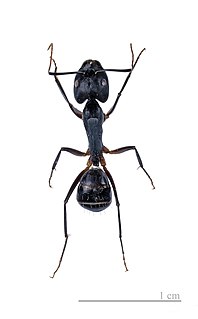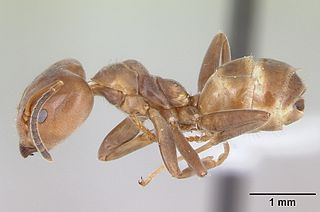
Lasius is a genus of formicine ants. The type species for this genus is the black garden ant, Lasius niger. Other major members, which live in drier heathland, are the cornfield ant, L. neoniger, and L. alienus. Other species include the temporary social parasites of the L. mixtus group and the hyper-social parasite Lasius fuliginosus. Lasius flavus is also a commonly seen species, building grassy hillocks in undisturbed pasture. In the Alps, these mounds - always aligned east to catch the first rays of the rising sun - have been traditionally used by goatherds as natural compasses.

The Formicinae are a subfamily within the Formicidae containing ants of moderate evolutionary development.

Ponerinae is a subfamily of ants in the Poneromorph subfamilies group, with about 1,600 species in 47 extant genera, including Dinoponera gigantea - one of the world's largest species of ant. Mated workers have replaced the queen as the functional egg-layers in several species of ponerine ants. In such queenless species, the reproductive status of workers can only be determined through ovarian dissections. Ponerinae is a subfamily of ants within the family of Formicidae. These ants typically nest in soil, forest litter, or rotting logs, and are predacious. They primarily prey on isopods. They mostly live in small colonies of up to 200 workers. They can be found mostly in tropical environments, but have been found in southeastern Canada and New York. Female workers have twelve segmented antennae, whereas male workers have 13 segmented antennae.

Myrmicinae is a subfamily of ants, with about 140 extant genera; their distribution is cosmopolitan. The pupae lack cocoons. Some species retain a functional sting. The petioles of Myrmicinae consist of two nodes. The nests are permanent and in soil, rotting wood, under stones, or in trees.

Dolichoderinae is a subfamily of ants, which includes species such as the Argentine ant, the erratic ant, the odorous house ant, and the cone ant. The subfamily presents a great diversity of species throughout the world, distributed in different biogeographic realms, from the Palearctic, Nearctic, Afrotropical region and Malaysia, to the Middle East, Australian, and Neotropical regions.

Trap-jaw ants are a genus (Odontomachus) of omnivorous ants found in the tropics and subtropics throughout the world.

Acropyga is a genus of small formicine ants. Some species can be indirect pests. A. acutiventris, which is found from India to Australia, tends subterranean, root-feeding mealybugs of the species Xenococcus annandalei. Living, gravid females are carried in the jaws of A. acutiventris queens during their nuptial flight, to establish the symbiotic association in founding colonies. Other Acropyga species have relationships with different species of mealybugs, and it could be a trait common to the whole genus.

Aneuretinae is a subfamily of ants consisting of a single extant species, Aneuretus simoni, and 9 fossil species. Earlier, the phylogenetic position of A. simoni was thought to be intermediate between primitive and advanced subfamilies of ants, but recent studies have shown it is the nearest living relative of subfamily Dolichoderinae.

Azteca is a strictly Neotropical genus of ants in the subfamily Dolichoderinae. The genus is very diverse and contains around 84 extant species and two fossil species. They are essentially arboreal and many species have mutualistic associations with particular plant species, where the genus Cecropia presents the most conspicuous association. In the Brazilian Amazonia, Azteca species are associated with species of Codonanthopsis.

Azteca alfari is a species of ant in the genus Azteca. Described by Carlo Emery in 1893, the species is widespread in Mexico, Central and South America. This ant has a mutualistic relationship with a Cecropia tree. The specific name alfari honours a Costa Rican zoologist Anastasio Alfaro.
Azteca angusticeps is a species of ant in the genus Azteca. Described by Carlo Emery in 1893, the species is widespread in North America and South America.
Azteca aurita is a species of ant in the genus Azteca. Described by Emery in 1893, the species is widespread in North America and South America.
Azteca beltii is a species of ant in the genus Azteca. Described by Carlo Emery in 1893, the species is endemic to North America and South America.

Azteca chartifex is a species of ant in the genus Azteca. Described by Forel in 1896, the species is endemic to various countries in North America and South America.
Azteca constructor is a species of ant in the genus Azteca. Described by Emery in 1896, the species is endemic to several countries in Central America and South America.
Azteca crassicornis is a species of ant in the genus Azteca. Described by Emery in 1893, the species is endemic to Brazil.
Azteca delpini is a species of ant in the genus Azteca. Described by Emery in 1893, the species is endemic to South America.
Azteca depilis is a species of ant in the genus Azteca. Described by Emery in 1893, the species is endemic to South America.

Azteca muelleri is a species of ant in the genus Azteca. Described by the Italian entomologist Carlo Emery in 1893, the species is native to Central and South America. It lives in colonies in the hollow trunk and branches of Cecropia trees. The specific name muelleri was given in honour of a German biologist Fritz Müller, who discovered that the small bodies at the petiole-bases of Cecropia are food bodies.












